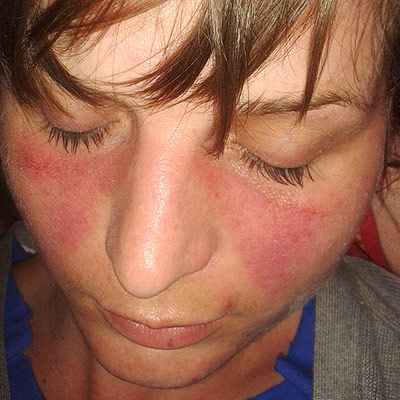Lupus
Overview
Lupus, technically known as systemic lupus erythematosus (SLE), is an autoimmune disease where the immune system attacks healthy tissue in various parts of the body. It predominantly affects women of childbearing age, particularly those of African, Caribbean, and Chinese descent.
The cause of SLE is unclear but involves a combination of genetic and environmental factors. Diagnosis is challenging and based on symptoms and blood tests.
There is no cure, but treatments can manage symptoms and reduce flares.
Signs and Symptoms
SLE is often called "the great imitator" because it can mimic other diseases. Common symptoms include painful and swollen joints, fever, chest pain, hair loss, mouth ulcers, swollen lymph nodes, fatigue, and a characteristic red rash on the face known as the butterfly rash.

Skin manifestations include chronic cutaneous (discoid) lupus, subacute cutaneous lupus, and acute cutaneous lupus. Other skin-related issues can include hair loss and mucosal ulcers.
Musculoskeletal symptoms involve joint pain and muscle aches, affecting more than 90% of patients. Blood-related symptoms include anaemia, low platelet count, and leukopenia.
Cardiovascular complications include pericarditis, myocarditis, and an increased risk of atherosclerosis. SLE can also cause pleuritis and other lung conditions, as well as kidney involvement leading to lupus nephritis.
Neuropsychiatric symptoms can range from headaches to severe cognitive and mood disorders.
Diagnosis
Diagnosing SLE involves a combination of clinical assessment and laboratory tests. The American College of Rheumatology (ACR) has established criteria for classification, including symptoms like malar rash, discoid rash, photosensitivity, oral ulcers, arthritis, serositis, renal disorder, neurological disorder, hematologic disorder, immunologic disorder, and a positive antinuclear antibody (ANA) test.

Pathophysiology
SLE is characterised by the production of autoantibodies against self-proteins, particularly nuclear antigens. These antibodies form immune complexes that deposit in tissues, causing inflammation and damage.
Apoptosis (programmed cell death) and defective clearance of apoptotic cells play a very important role in the disease's pathogenesis. Genetic factors, including mutations in the HLA class I and II genes, contribute to susceptibility.
Treatment
There is no cure for SLE, but treatments focus on managing symptoms and preventing flares. Medications include nonsteroidal anti-inflammatory drugs (NSAIDs), corticosteroids, immunosuppressants, antimalarials like hydroxychloroquine, and biologics such as belimumab.
Disease-modifying antirheumatic drugs (DMARDs) are used to reduce disease activity and steroid dependence. In severe cases, immunosuppressive drugs are necessary.
Prognosis
The prognosis for SLE has improved significantly with advances in treatment. Most patients can expect a normal lifespan, although the disease increases the risk of cardiovascular complications.
Mortality rates are higher among men and children with SLE compared to women. Early diagnosis and appropriate management are very important to improving outcomes.
Epidemiology
SLE affects approximately 20 to 70 per 100,000 people globally, with higher rates in women, particularly those of non-European descent. The disease's prevalence varies by region, with higher rates reported in the US and France and lower rates in Iceland and Japan.


Self-assessment MCQs (single best answer)
Which of the following is a common initial symptom of Systemic Lupus Erythematosus (SLE)?
Which skin manifestation is most commonly associated with Lupus?
Which laboratory test is highly specific for diagnosing SLE?
What is the primary cause of systemic lupus erythematosus (SLE)?
Which medication is commonly used to treat lupus but has potential side effects including increased risk for cardiovascular disease?
Which of the following is a neuropsychiatric symptom associated with SLE?
What characteristic histological finding is associated with lupus nephritis in SLE?
Which of the following is a risk factor for the development of SLE?
What percentage of people with SLE develop neuropsychiatric symptoms?
Which test helps in detecting deposits of immunoglobulins and complement proteins in the skin of SLE patients?
Dentaljuce
Dentaljuce provides Enhanced Continuing Professional Development (CPD) with GDC-approved Certificates for dental professionals worldwide.
Founded in 2009 by the award-winning Masters team from the School of Dentistry at the University of Birmingham, Dentaljuce has established itself as the leading platform for online CPD.
With over 100 high-quality online courses available for a single annual membership fee, Dentaljuce offers comprehensive e-learning designed for busy dental professionals.
The courses cover a complete range of topics, from clinical skills to patient communication, and are suitable for dentists, nurses, hygienists, therapists, students, and practice managers.
Dentaljuce features Dr. Aiden, a dentally trained AI-powered personal tutor available 24/7 to assist with queries and provide guidance through complex topics, enhancing the learning experience.
Check out our range of courses, or sign up now!


